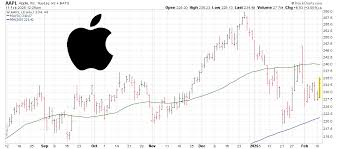Apple Stock: A Comprehensive Overview 1. Introduction
Apple Inc. (AAPL) is one of the most valuable and influential technology companies in the world. Founded in 1976 by Steve Jobs, Steve Wozniak, and Ronald Wayne, Apple has grown into a global leader in consumer electronics, software, and digital services. The company’s stock, listed on the NASDAQ under the ticker symbol AAPL, has been a favorite among investors due to its consistent innovation, strong financials, and brand loyalty.
Apple has revolutionized multiple industries, including personal computing, mobile devices, music streaming, and cloud services. Its ability to adapt to changing market trends and consumer demands has made it a dominant force in the technology sector.
2. Company Background and Growth
Apple started as a small garage project and transformed into a tech giant with a market capitalization that has surpassed $3 trillion. Some key milestones in its journey include:
- 1976: Apple Computer Company was founded, and the Apple I was introduced.
- 1980: Apple went public with an IPO at $22 per share.
- 1984: The introduction of the Macintosh revolutionized personal computing.
- 1997: Steve Jobs returned to Apple, leading to a resurgence of the company.
- 2001: The iPod was launched, transforming the music industry.
- 2007: Introduction of the iPhone revolutionized the smartphone industry.
- 2011: Passing of Steve Jobs and Tim Cook taking over as CEO.
- 2015: Apple Watch entered the wearable technology market.
- 2020: Apple became the first U.S. company to reach a $2 trillion market cap.
- 2022: Apple briefly surpassed a $3 trillion market valuation.
3. Apple’s Stock Performance Over the Years
Apple’s stock has demonstrated impressive long-term growth. Despite short-term fluctuations, the stock has consistently outperformed the broader market, driven by strong earnings, innovative product launches, and expanding services revenue.
3.1 Historical Stock Performance
Apple has undergone multiple stock splits to make shares more accessible to investors:
- 1987: 2-for-1 split
- 2000: 2-for-1 split
- 2005: 2-for-1 split
- 2014: 7-for-1 split
- 2020: 4-for-1 split
These splits have made Apple shares more affordable while increasing shareholder value over time. Despite these splits, Apple’s stock price has consistently climbed, rewarding long-term investors with significant returns.
4. Financial Overview
Apple is known for its strong financial health. Key metrics include:
- Revenue (2023): Over $400 billion
- Net Income (2023): $100+ billion
- Market Capitalization: Around $2.5–$3 trillion (varies with market trends)
- Dividend Yield: Around 0.5%
4.1 Revenue Breakdown
Apple generates revenue from various segments:
- iPhone: 50%+ of total revenue
- Mac and iPad: 15%
- Wearables (Apple Watch, AirPods): 10%
- Services (App Store, iCloud, Apple Music, Apple Pay, etc.): 20%+
Apple’s services segment is one of its fastest-growing revenue sources, contributing significantly to its overall financial performance. This shift towards recurring revenue from digital services helps Apple maintain steady growth even when hardware sales fluctuate.
5. Apple’s Competitive Advantage
Apple’s stock remains strong due to several factors:
- Brand Loyalty: Customers are deeply invested in Apple’s ecosystem.
- Innovation: Continuous product development, including AI, AR/VR (Vision Pro), and custom silicon chips.
- Strong Financials: High profit margins, strong cash flow, and a solid balance sheet.
- Expanding Services Sector: Increasing revenue from subscriptions and digital services.
- Supply Chain Management: Efficient production and logistics allow Apple to maximize profitability.
6. Market Trends and Future Outlook
Apple’s stock is influenced by:
- New Product Launches: iPhone iterations, MacBook improvements, AR/VR developments.
- Economic Conditions: Interest rates, inflation, and global supply chain issues.
- Technological Shifts: AI integration, chip development, and cloud services expansion.
- Regulatory Scrutiny: Anti-trust investigations and privacy regulations may impact operations.
With Apple’s continued investment in emerging technologies such as artificial intelligence and augmented reality, the company is positioning itself for future growth beyond just hardware sales. Its recent push into financial services, healthcare, and autonomous technology further solidifies its long-term vision.
7. Apple Stock Chart Analysis
Apple’s stock exhibits long-term growth with periodic pullbacks. Technical indicators like moving averages, RSI, and earnings reports play a crucial role in stock movements.
[Insert Chart Showing Apple Stock Performance Over 10 Years]
Apple’s stock has remained resilient even during economic downturns, showcasing its ability to weather market fluctuations. The company’s ability to consistently generate revenue and maintain strong profit margins makes it a preferred choice for long-term investors.
8. Market Screener Insights
Apple remains a strong buy for long-term investors. Current analyst ratings suggest:
- Buy Ratings: 70%
- Hold Ratings: 25%
- Sell Ratings: 5%
Apple’s stock is favored by institutional investors and hedge funds, further indicating confidence in its long-term growth potential.
9. Risks and Challenges
Despite Apple’s dominance, it faces several risks:
- Regulatory Issues: Governments worldwide are increasing scrutiny on big tech companies.
- Supply Chain Disruptions: Geopolitical tensions, especially with China, could impact production.
- Competition: Companies like Samsung, Google, and emerging players continue to challenge Apple’s market share.
- Innovation Pressure: Apple must continuously innovate to maintain its edge in the market.
10. Conclusion
Apple’s stock is a powerhouse in the market, offering long-term stability and growth. While short-term volatility exists, its innovative edge, strong financials, and expanding services ensure continued success. Investors looking for a reliable blue-chip tech stock will find Apple to be a solid investment choice.
Why Apple Remains a Strong Investment
Apple’s ability to evolve with technology trends and consumer demands has kept it at the forefront of the industry. Its commitment to innovation, ecosystem expansion, and financial strength ensures its resilience even in challenging market conditions.
Final Thoughts
As Apple continues to innovate and expand its revenue streams, it remains one of the most attractive stocks in the market. While risks exist, its strong fundamentals, dedicated customer base, and ability to generate consistent revenue make it a key player in any long-term investment portfolio. Apple’s stock has proven time and time again that it can withstand economic uncertainty and deliver substantial returns for investors.






